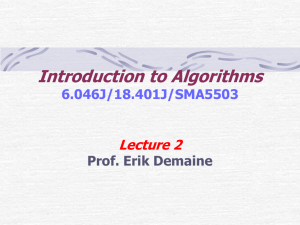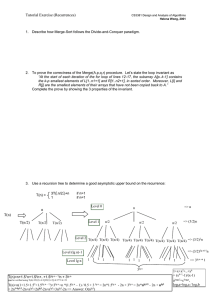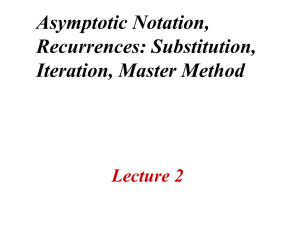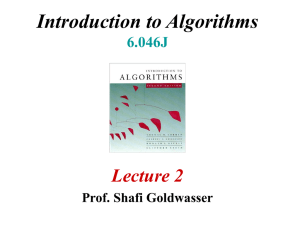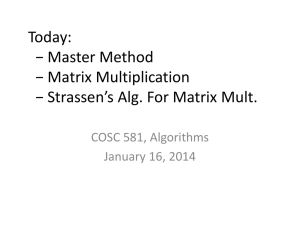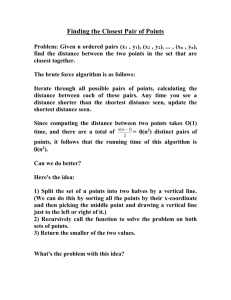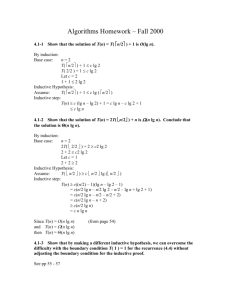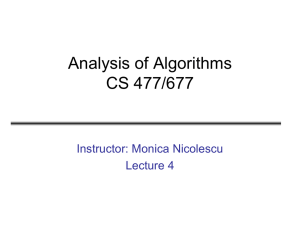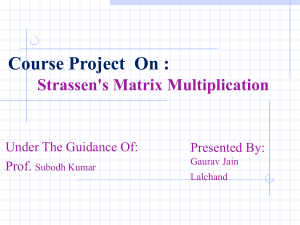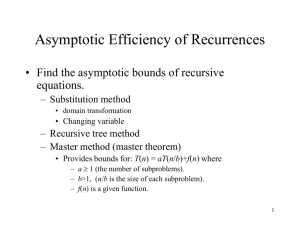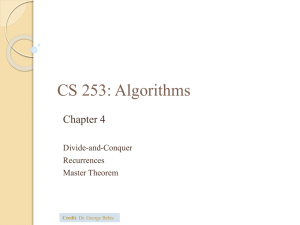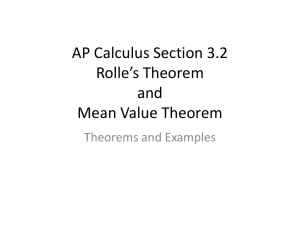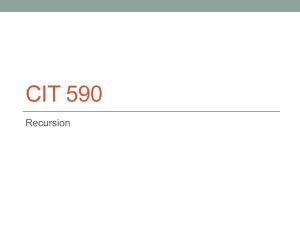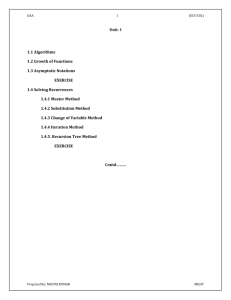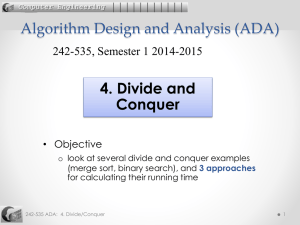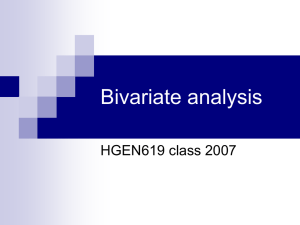Lecture 5, January 18
advertisement
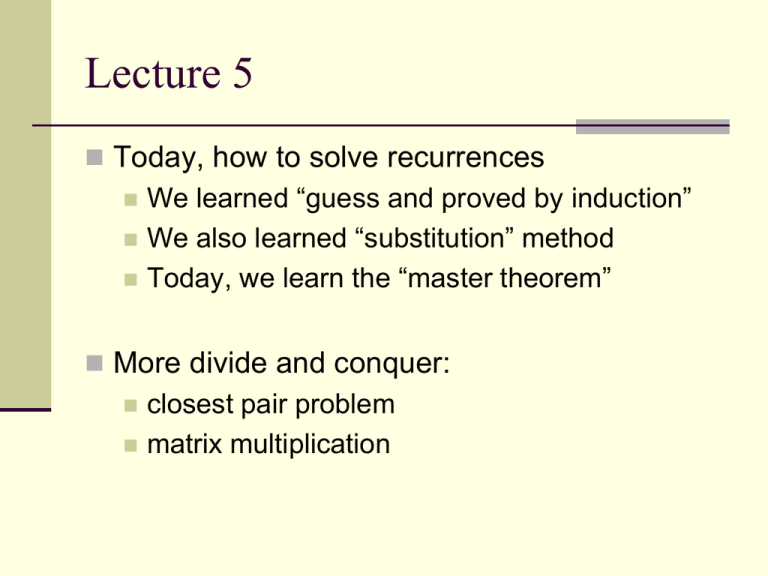
Lecture 5
Today, how to solve recurrences
We learned “guess and proved by induction”
We also learned “substitution” method
Today, we learn the “master theorem”
More divide and conquer:
closest pair problem
matrix multiplication
Master Theorem
Theorem 4.1 (CLRS, Theorem 4.1) Let a ≥ 1 and b > 1
be constants. Let f(n) be a function and let T(n) be
defined on the nonnegative integers by
T(n) = aT(n/b) + f(n).
Then
log a
n b
log a
T ( n ) n b log n
f (n )
log a
f (n) O n b
0
log a
f (n) n b
c 1
log b a
f (n) n
AND
af ( n / b ) cf ( n ) for large n
Note
Only apply to a particular family of
recurrences.
f(n) is positive for large n.
Key is to compare f(n) with nlog_b a
Case 2, more general is f(n) = Θ( nlog_b a lgkn).
Then the result is T(n) = Θ( nlog_b a lgk+1n).
Sometimes it does not apply. Ex. T(n) =
4T(n/2) + n2 /logn.
Proof ideas of Master Theorem
Consider a tree with T(n) at the root, and apply the recursion to
each node, until we get down to T(1) at the leaves. The first
recursion is T(n) = aT(n/b) + f(n), so assign a cost of f(n) to the
root. At the next level we have “a” nodes, each with a cost of
T(n/b). When we apply the recursion again, we get a cost of
af(n/b) for all of these. At the next level we have a2 nodes, each
with a cost of T(n/b2). We get a cost of a2f(n/b2). We continue
down to T(1) at the leaves. There are alog_b n leaves and each
costs Θ(1), which gives Θ(alog_b n). The total cost associated with
f is Σ 0 ≤ i ≤ log_b n - 1 ai f(n/bi).
Thus T(n) = Θ(n log_b a) + Σ 0 ≤ i ≤ (log_b n) - 1 ai f(n/bi).
The three cases now come from deciding which term is
dominant. In case (1), the Θ term is dominant. In case (2), the
terms are roughly equal (but the second term has an extra lg n
factor). In case (3), the f(n) term is dominant. The details are
somewhat painful, but can be found in CLRS, pp. 76-84.
Idea of master theorem
f (n)
a
f (n/b) f (n/b) … f (n/b)
a
h = logbn
f (n/b2) f (n/b2) … f (n/b2)
T (1)
#leaves = ah
= alogbn
= nlogba
f (n)
a f (n/b)
a2 f (n/b2)
…
Recursion tree:
nlogbaT (1)
Three common cases
Compare f (n) with nlogba:
1. f (n) = O(nlogba – ) for some constant > 0.
• f (n) grows polynomially slower than nlogba
(by an n factor).
Solution: T(n) = (nlogba) .
Recursion tree:
f (n)
a
f (n/b) f (n/b) … f (n/b)
a
h = logbn
f (n/b2) f (n/b2) … f (n/b2)
CASE 1: The weight increases
geometrically from the root to the
T (1) leaves. The leaves hold a constant
fraction of the total weight.
f (n)
a f (n/b)
a2 f (n/b2)
…
Idea of master theorem
These functions increase
from top to bottom
geometrically, hence we
only need to have the
last bottom term
nlogbaT (1)
(nlogba)
Case 2
Compare f (n) with nlogba:
2. f (n) = (nlogba lgkn) for some constant k 0.
• f (n) and nlogba grow at similar rates.
• This is clear for k=0. For k>0, the intuition is
that lgk n factor remain for constant fraction
of levels, hence sum to the following
Solution: T(n) = (nlogba lgk+1n) .
Idea of master theorem
Recursion tree:
f (n)
f (n)
a f (n/b)
a2 f (n/b2)
…
a
f (n/b) f (n/b) … f (n/b)
a
h = logbn
f (n/b2) f (n/b2) … f (n/b2)
All levels same
T (1)
CASE 2: (k = 0) The weight
is approximately the same on
each of the logbn levels.
nlogbaT (1)
(nlogbalg n)
Case 3, c<1, akf(n/bk) geometrically
decreases hence = Θ(f(n))
Compare f (n) with nlogba:
3. f (n) = (nlogba + ) for some constant > 0.
• f (n) grows polynomially faster than nlogba (by
an n factor),
and f (n) satisfies the regularity condition that
a f (n/b) c f (n) for some constant c < 1.
Solution: T(n) = ( f (n)) .
Recursion tree:
f (n)
a
f (n/b) f (n/b) … f (n/b)
a
h = logbn
f (n/b2) f (n/b2) … f (n/b2)
CASE 3: The weight decreases
geometrically from the root to the
T (1) leaves. The root holds a constant
fraction of the total weight.
af(n/b)<(1-ε)f(n)
f (n)
a f (n/b)
a2 f (n/b2)
…
Idea of master theorem
nlogbaT (1)
( f (n))
Examples for the Master Theorem
The Karatsuba recurrence has a = 3, b = 2, f(n) = cn. Then case
1 applies, and so T(n) = Θ(n l og_2 3 ), as we found.
The mergesort recurrence has a = 2, b = 2, f(n) = n. Then case 2
applies, and so T(n) = Θ(n lg n).
Finally, a recurrence like T(n) = 3T(n/2) + n2 gives rise to case 3.
In this case f(n) = n2, so 3f(n/2) = 3 (n/2)2 = (3/4) n2 ≤ c n2 for c =
3/4, and so T(n) = Θ(n2).
Note that the master theorem does not cover all cases. In
particular, it does not cover the case
T(n) = 2 T(n/2) + n / lg n
since then the only applicable case is case 3, but then the
inequality involving f does not hold.
Closest pair problem
Input:
A set of points P = {p1,…, pn} in two
dimensions
Output:
The pair of points pi, pj that minimize the
Euclidean distance between them.
Distances
Euclidean distance
y1
x1 , y 1
x2 , y2
y2
x1
x2
x1 , y1 x 2 , y 2
x1 x 2
2
y1 y 2
2
Closest Pair Problem
Closest Pair Problem
Divide and Conquer
O(n2) time algorithm is easy
Assumptions:
No two points have the same x-coordinates
No two points have the same y-coordinates
How do we solve this problem in 1 dimension?
Sort the number and walk from left to right to find
minimum gap.
Divide and Conquer
Divide and conquer has a chance to do better
than O(n2).
We can first sort the points by their x-
coordinates and sort also by y-coordinates
Closest Pair Problem
Divide and Conquer for the Closest
Pair Problem
Divide by x-median
Divide
L
R
Divide by x-median
Conquer
L
R
1
2
Conquer: Recursively solve L and R
Combination I
L
R
2
Take the smaller one of 1 , 2 : = min(1 , 2 )
Combination II
Is there a point in L and a point in R whose distance is
smaller than ?
L
R
= min(1 , 2 )
Combination II
If the answer is “no” then we are done!!!
If the answer is “yes” then the closest such
pair forms the closest pair for the entire set
How do we determine this?
Combination II
Is there a point in L and a point in R whose distance is
smaller than ?
L
R
Combination II
Is there a point in L and a point in R whose distance is
smaller than ?
L
R
Need only to consider the narrow band
O(n) time
Combination II
Is there a point in L and a point in R whose distance is
smaller than ?
L
R
Denote this set by S, assume Sy is the sorted
list of S by the y-coordinates.
Combination II
There exists a point in L and a point in R whose
distance is less than if and only if there exist
two points in S whose distance is less than .
If S is the whole thing, did we gain anything?
CLAIM: If s and t in S have the property that ||st|| < , then s and t are within 15 positions of
each other in the sorted list Sy.
Combination II
Is there a point in L and a point in R whose distance is
smaller than ?
L
R
There are at most one point in each box of size δ/2 by δ/2.
Thus s and t cannot be too far apart.
Closest-Pair
Preprocessing:
Construct Px and Py as sorted-list by x- and y-coordinates
Closest-pair(P, Px,Py)
Divide
Construct L, Lx , Ly and R, Rx , Ry
Conquer
Let 1= Closest-Pair(L, Lx , Ly )
Let 2= Closest-Pair(R, Rx , Ry )
Combination
Let = min(1 , 2 )
Construct S and Sy
For each point in Sy, check each of its next 15 points down
the list
If the distance is less than , update the as this smaller
distance
Complexity Analysis
Preprocessing takes O(n lg n) time
Divide takes O(n) time
Conquer takes 2 T(n/2) time
Combination takes O(n) time
T(n) = 2T(n/2) + cn
So totally takes O(n lg n) time.
Matrix Multiplication
Suppose we multiply two NxN matrices together.
Regular method is NxNxN = N3 multiplications
O(N3)
Can we Divide and Conquer?
A11
A =
A 21
A12
A 22
B=
B 11
B 21
B 12
B 22
C 11
C= A*B =
C 21
C11 = A11*B11 + A12*B21
C12 = A11*B12 + A12*B22
C21 = A21*B11 + A22*B21
C22 = A21*B12 + A22*B22
Complexity : T(N) = 8T(N/2) + O(N2)
= O(Nlog28) = O(N3)
No improvement
C 12
C 22
Strassen’s Matrix Multiplication
P1 = (A11+ A22)(B11+B22)
P2 = (A21 + A22) * B11
P3 = A11 * (B12 - B22)
P4 = A22 * (B21 - B11)
P5 = (A11 + A12) * B22
P6 = (A21 - A11) * (B11 + B12)
P7 = (A12 - A22) * (B21 + B22)
C11 = P1 + P4 - P5 + P7
C12 = P3 + P5
C21 = P2 + P4
C22 = P1 + P3 - P2 + P6
And do this recursively as usual.
Volker
Strassen
Time analysis
T(n) = 7T(n/2) + O(n2 )
= 7logn
by the Master Theorem
=nlog7
=n2.81
Best bound: O(n2.376) by CoppersmithWinograd.
Best known (trivial) lower bound: Ω(n2).
Open: what is the true complexity of matrix
multiplication?
